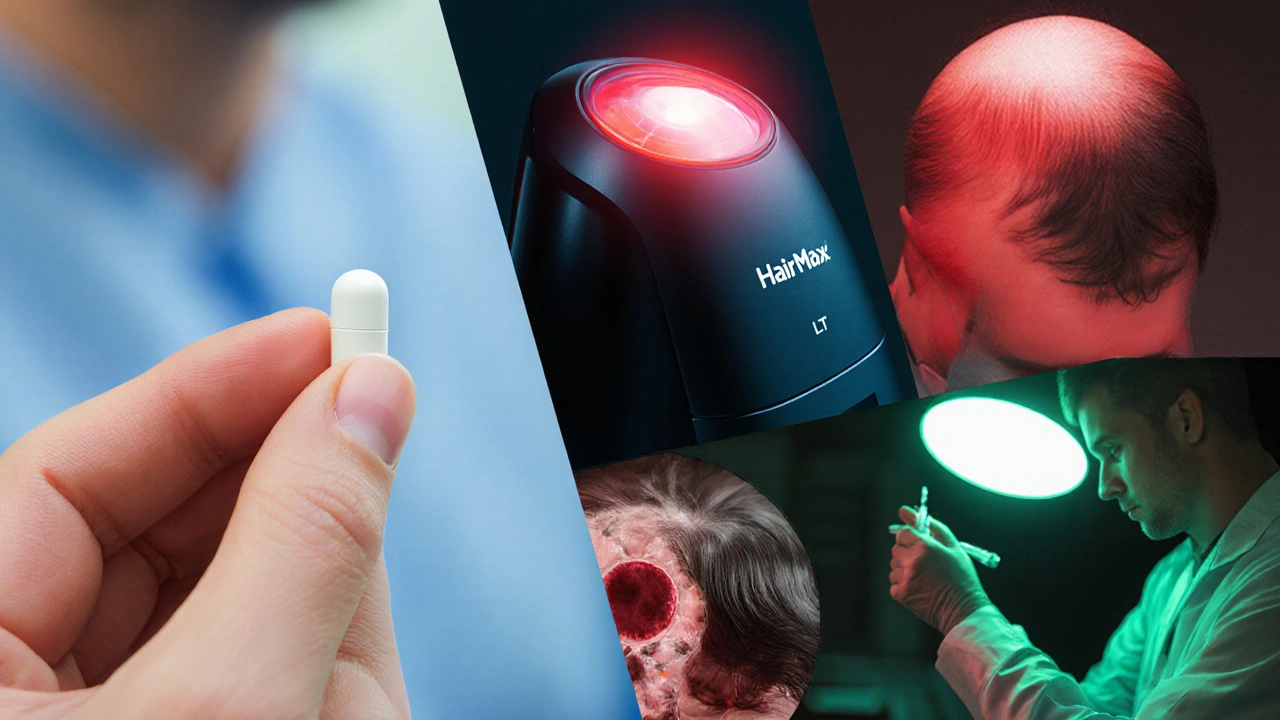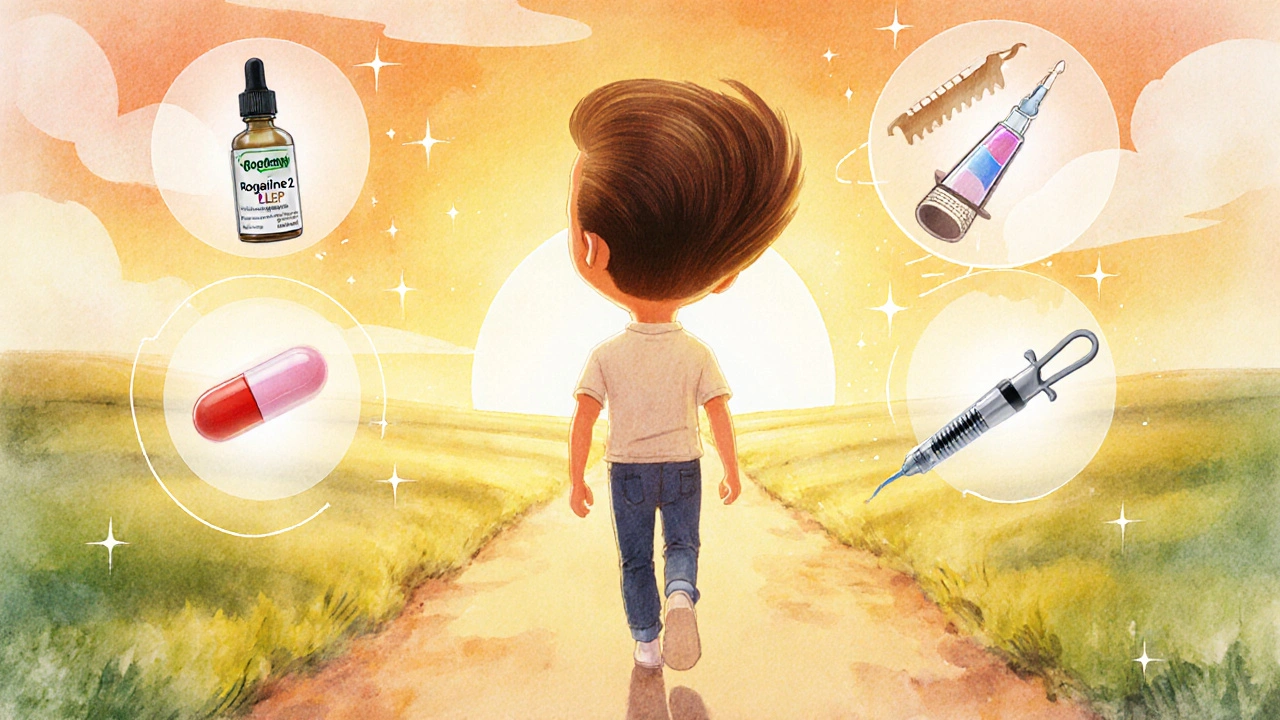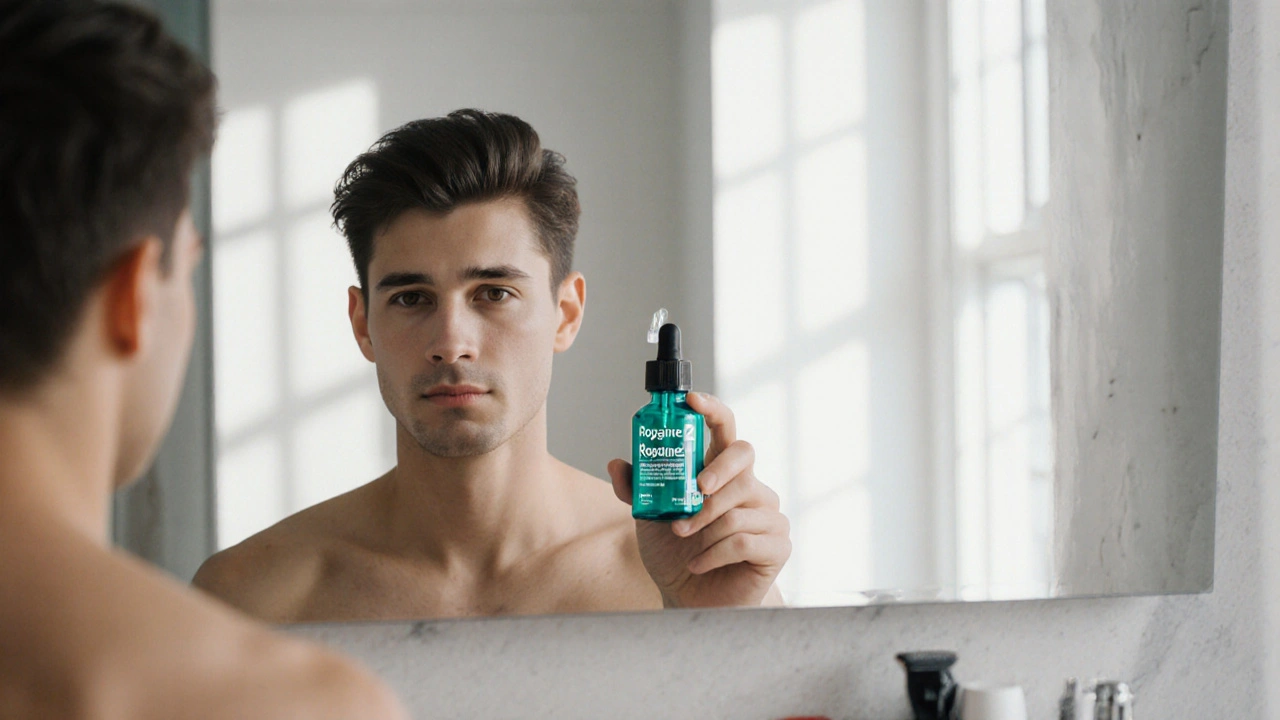Rogaine 2 vs Hair Loss Alternatives Comparison Tool
If you’ve stared at a thinning crown and wondered whether the next bottle on the shelf will finally work, you’re not alone. The market is flooded with shampoos, oral pills, devices, and even clinic‑based procedures, each promising a fuller head of hair. Below, we cut through the hype and put Rogaine 2 side‑by‑side with the most talked‑about rivals, so you can decide what fits your scalp, budget, and lifestyle.
TL;DR - Quick Takeaways
- Rogaine 2 (2% minoxidil) is an FDA‑cleared topical that shows visible regrowth in 3-6 months for most users.
- Finasteride (Propecia) works systemically, delivering faster results for male pattern baldness but carries hormonal side effects.
- Low‑level light therapy devices (HairMax, LLLT caps) are safe, drug‑free, but need daily use and modest gains.
- Topical ketoconazole or caffeine shampoos (Nioxin, Regenepure) help maintain a healthy scalp but rarely regrow beyond existing hair.
- Procedures like PRP or hair transplant deliver the most dramatic change but involve higher cost and clinical visits.
What Is Rogaine2?
Rogaueine 2 is a topical solution containing 2% minoxidil, the only over‑the‑counter medication approved by the U.S. Food and Drug Administration to treat androgen‑dependent hair loss in both men and women. It comes in a 60ml bottle with a dropper for targeted application on the scalp.
Minoxidil was originally a blood‑pressure drug; when patients reported unexpected hair growth, the formula was repurposed for dermatology. Rogaine2 delivers a modest concentration that balances effectiveness with a lower chance of irritation compared with the 5% formulation.
How Minoxidil Works
The exact mechanism isn’t fully settled, but three key actions are widely accepted:
- Vasodilation - widening scalp blood vessels, boosting oxygen and nutrient delivery.
- Prolonging the anagen (growth) phase of hair follicles, allowing strands to grow longer before shedding.
- Activating potassium channels that may signal dormant follicles to re‑enter the growth cycle.
Because the effect is localized, systemic side effects are rare, making it a go‑to first‑line option for many users.

Popular Alternatives on the Market
Below are the eight most frequently compared products or procedures, each with a brief description and its primary claim.
Propecia is a prescription pill whose active ingredient, finasteride, blocks the conversion of testosterone to dihydrotestosterone (DHT), the hormone largely responsible for follicle miniaturization in men. It’s taken once daily and often shows noticeable thickening within three months, but it can cause sexual side effects and is not approved for women.
Nioxin is a line of shampoos, conditioners, and scalp treatments formulated with biotin, niacin, and botanical extracts. The brand markets itself as a scalp‑health system that reduces shedding and adds volume, though its ingredients don’t directly stimulate new growth.
HairMax (and similar low‑level light therapy devices) emit red light at 655nm to energize follicular cells. Clinical trials show a 30‑40% improvement in hair density after six months of twice‑daily use.
Nutrafol is an oral supplement that blends saw‑tooth oak, ashwagandha, and marine complex to address stress, inflammation, and hormonal balance. Users report slower thinning, but measurable regrowth varies.
Ketoconazole Shampoo (e.g., Regenepure) contains an antifungal that also reduces scalp inflammation and DHT on the surface. It’s a useful adjunct to other therapies but typically doesn’t grow new hair on its own.
Platelet‑Rich Plasma (PRP) Therapy involves drawing a small amount of the patient’s blood, concentrating platelets, and injecting the serum into the scalp. Growth factors in PRP can reactivate dormant follicles, and multiple sessions often yield the most dramatic gains among non‑surgical options.
Bosley Hair Transplant is a surgical procedure that relocates healthy follicles from the back of the scalp to balding areas. It offers permanent, natural‑looking results but requires a substantial financial and recovery commitment.
Low‑Level Light Therapy (LLLT) Caps are wearable devices that provide uniform light exposure across the scalp. They’re marketed as a convenient, drug‑free alternative to topical solutions, though the data suggests modest improvement.
Head‑to‑Head Comparison
| Option | Active Ingredient / Method | Application | Typical Cost / Month | FDA Status | Result Timeline | Common Side‑Effects |
|---|---|---|---|---|---|---|
| Rogaine2 | 2% Minoxidil | Topical, twice daily | ≈$35 | OTC, FDA‑cleared | 3-6months | Mild scalp irritation, itching |
| Propecia | Finasteride 1mg | Oral, once daily | ≈$35 (generic) | Prescription, FDA‑approved | 1-4months | Sexual dysfunction, mood changes |
| HairMax LLLT | Red‑light 655nm | Device, 2×daily 15min | ≈$70 | FDA‑cleared device | 4-6months | None reported |
| Nutrafol | Botanical blend | Oral capsules, daily | ≈$80 | Supplement (not FDA‑regulated) | 5-8months | GI upset, rare allergic reaction |
| Ketoconazole Shampoo | 2% Ketoconazole | Wash 2-3×week | ≈$20 | OTC (prescription strength available) | 2-4months | Dry scalp, rare irritation |
| PRP Therapy | Autologous platelet‑rich plasma | Clinic‑based injections, 3‑month interval | ≈$300‑$600 per session | Medical procedure (no FDA‑clearance) | 2-4months after series | Bruising, mild discomfort |
| Hair Transplant (Bosley) | Surgical follicle relocation | One‑time surgical session | ≈$4000‑$8000 (depends on graft count) | Medical procedure (FDA‑regulated clinics) | 6-12months for final density | Scarring, postoperative pain |
Choosing the Right Path for Your Hair
Not every solution fits every person. Here’s a quick decision guide:
- Budget‑conscious and drug‑averse? Start with Rogaine2 or a ketoconazole shampoo. They’re cheap, easy to get, and have limited side‑effects.
- Looking for faster, stronger results and don’t mind a prescription? Finasteride (Propecia) often outperforms topical minoxidil in men with advanced thinning.
- Prefer a tech‑based, non‑chemical approach? Low‑level light devices like HairMax provide a safe, daily routine but require patience for moderate gains.
- Concerned about long‑term health and want a holistic boost? Nutraceuticals such as Nutrafol address stress and hormone balance, complementing any topical regimen.
- Ready to invest for dramatic, permanent change? Surgical transplant or a series of PRP sessions can restore a dense hairline, but they demand higher cost and clinic visits.
Most dermatologists recommend a combination: minoxidil on the crown, finasteride for the frontal area, and a gentle anti‑DHT shampoo to keep the scalp clean. Adding a light‑therapy device or PRP sessions can accelerate results if the budget allows.
Common Mistakes and Pro Tips
Even the best product fails if you use it wrong. Avoid these pitfalls:
- Inconsistent application. Minoxidil needs twice‑daily dosing for at least four months before you can judge effectiveness.
- Rushing the timeline. Hair grows about 0.5inch per month; expect visible changes after several cycles.
- Skipping scalp prep. Clean, dry skin absorbs minoxidil better. Avoid heavy conditioners right before use.
- Mixing products indiscriminately. Layering multiple topical solutions can dilute efficacy or increase irritation.
- Ignoring medical history. Men with prostate issues should discuss finasteride with a physician; women of child‑bearing age should avoid minoxidil concentrations above 2% without guidance.
Pro tip: Keep a simple log of application dates, any scalp reactions, and photos every month. Seeing incremental changes helps you stay motivated and spot early side‑effects.

Frequently Asked Questions
Can I use Rogaine2 and Propecia together?
Yes, many clinicians prescribe the combo because they work on different pathways: minoxidil stimulates follicle growth locally, while finasteride reduces DHT systemically. Monitoring for side‑effects is advisable.
Is a 2% minoxidil solution strong enough for men?
For mild to moderate thinning, 2% works for many. Men with extensive balding often switch to the 5% version for quicker results, but the lower concentration reduces irritation risk.
How long should I keep using Rogaine2 before stopping?
If you see stable regrowth, continue indefinite use. Stopping typically leads to shedding of the newly grown hair within a few months.
Are light‑therapy caps safe for daily use?
They emit low‑energy red light, which is non‑invasive and has no documented systemic side‑effects. The main issue is commitment-most studies used twice‑daily sessions.
What’s the biggest factor that determines success?
Consistency. Whether you stick to minoxidil, finasteride, or a device, regular use over several months outweighs the specific product’s potency.
